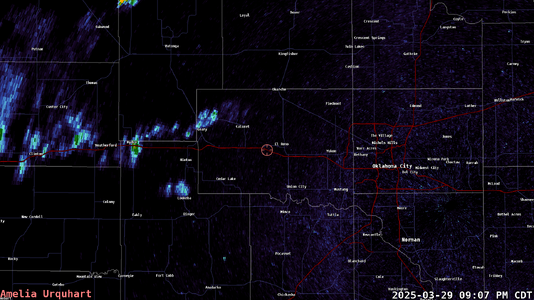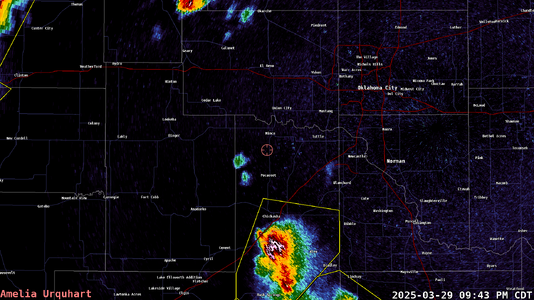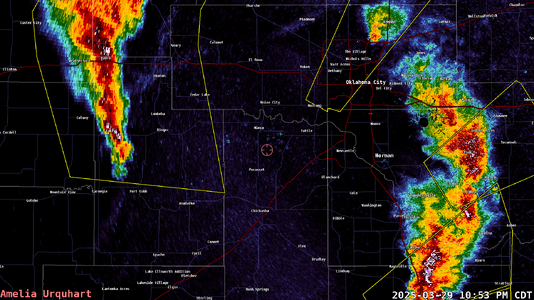Amelia Urquhart
EF0
I started my day by waiting for four hours in Apache, Oklahoma hoping against the odds for the dryline to fire during the daytime. At around 7:15 PM, I bailed on the southern Oklahoma dryline target to reposition to the forming squall line up north. Unbeknowst to me, the dryline had finally decided to fire near Burkburnett, Texas. Around 9 PM, when I had gotten north of Calumet on my way to Kingfisher, I noticed the cell complex to my south, still struggling to organize but much healthier than the anemic quasi-linear cells to the north. Once I restarted my GPS logger, my situation looked like this:

I was originally planning to intercept the Burkburnett cell around Lindsay, hoping that it would wait until then to catch the RM vector and that it would be slow enough for me to be able to get ahead of it. However, the cell split and threw a left mover northwards toward Chickasha. I positioned north of Pocasset and was able to take the following timelapse.
View attachment 20250329-chickashaLeftMover.mp4

After the left mover had passed through and the inflow sector crapvection started to rain heavy enough to force me to put the camera in the car, I started to shift east to get the lightning on the back side of the storm. While it flashed frequently, exposed bolts were few and far between, and I pointed my camera west to capture the nighttime structure of the cold front squall line. While I'm happier with that shot on a technical level, it can't quite match the cool factor of the exposed left-moving meso over Chickasha.
View attachment 20250329-roundTwo.mp4


I was originally planning to intercept the Burkburnett cell around Lindsay, hoping that it would wait until then to catch the RM vector and that it would be slow enough for me to be able to get ahead of it. However, the cell split and threw a left mover northwards toward Chickasha. I positioned north of Pocasset and was able to take the following timelapse.
View attachment 20250329-chickashaLeftMover.mp4

After the left mover had passed through and the inflow sector crapvection started to rain heavy enough to force me to put the camera in the car, I started to shift east to get the lightning on the back side of the storm. While it flashed frequently, exposed bolts were few and far between, and I pointed my camera west to capture the nighttime structure of the cold front squall line. While I'm happier with that shot on a technical level, it can't quite match the cool factor of the exposed left-moving meso over Chickasha.
View attachment 20250329-roundTwo.mp4

